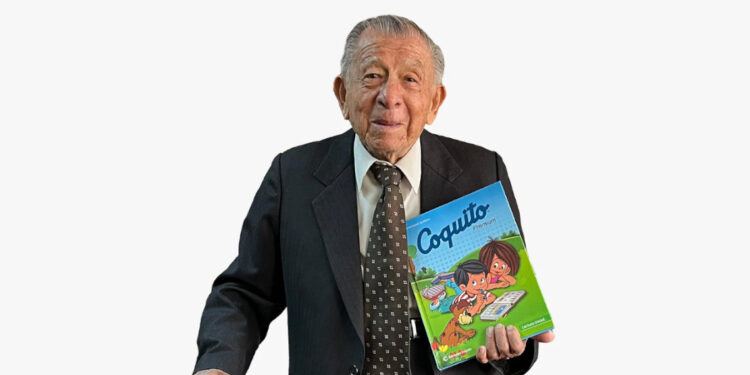Coquito is a book that has accompanied millions of children in Peru and Latin America on their first steps toward reading. Written by the Peruvian educator Everardo Zapata Santillana in 1955, Coquito has become a classic in school education, used in schools and homes across the country and beyond.
Coquito: Its Origin
In 1948, Professor Zapata was sent to the district of Punta de Bombón (Arequipa) with the mission of creating a school, N.º 9638. There, he observed that the reading teaching methods used at that time were not suitable, as they followed American or French models, which he considered not practical for Peruvian children. It was then that he decided to create his own reading method, and seven years later, in 1955, he published it under the name “Coquito.” “One night, I dreamed that I had a son, and his name was Coquito; when I woke up, I grabbed the book and baptized it in the sink in my room,” Don Everardo Zapata Santillana recounted about the origin of his book’s name.

Since its launch, Coquito has become a fundamental pillar of basic education in Peru. Its use is not limited to schools; it has also been adopted by many families as an essential tool for teaching at home. The simplicity of its method has allowed both teachers and parents to guide children effectively in their literacy process.
The Impact of Coquito in Peru and Latin America
Coquito is recognized as one of the most effective methods for teaching reading in Peru. Using a syllabic approach, the book gradually presents letters and sounds, making comprehension and learning easier. Through colorful illustrations and practical exercises, Coquito captures the attention of children, helping them relate words to images and sounds.
Despite the evolution of educational methods and the arrival of new technologies and teaching approaches, the Coquito book remains relevant.
Coquito’s influence extends beyond Peru’s borders. The book has been translated into various languages and used in countries like Bolivia, Ecuador, Venezuela, Colombia, Paraguay, Argentina, Mexico, Chile, and Uruguay. Its focus on literacy has resonated with diverse communities, becoming a valuable resource for teaching reading in the region.
In many of these countries, Coquito has helped improve literacy rates and foster a culture of learning among new generations. Its success is due not only to its educational content but also to the emotional connection it generates in students, who associate Coquito with their first achievements in reading.
Coquito in the Digital Era
Today, Coquito has adapted to changes in education and technology. There are digital versions of the book and interactive applications that incorporate the traditional teaching method with modern resources. This allows Everardo Zapata’s legacy to remain relevant in a constantly evolving world.
Despite the evolution of educational methods and the arrival of new technologies, the Coquito book is still alive. Updated editions incorporate language changes and new illustrations while maintaining the same syllabic method that has proven effective for more than half a century.
A Lasting Legacy
Coquito is much more than a book; it is a symbol of literacy and education in Peru and Latin America. Through its pages, Everardo Zapata left a legacy that has transformed the lives of millions of children, providing them with the necessary tools to face the world with confidence.
The impact of Coquito on Peruvian and Latin American education is undeniable. Thanks to its simple and effective methodology, the book has helped countless students learn to read and write, opening the doors to knowledge and culture.
Today, when we see a child reading Coquito, we are not only witnessing the learning of reading but also the strengthening of an educational tradition that endures over time. For Peruvians and the Peruvian community abroad, Coquito is a source of pride, a legacy that continues to inspire new generations to discover the joy of reading and the value of education.




